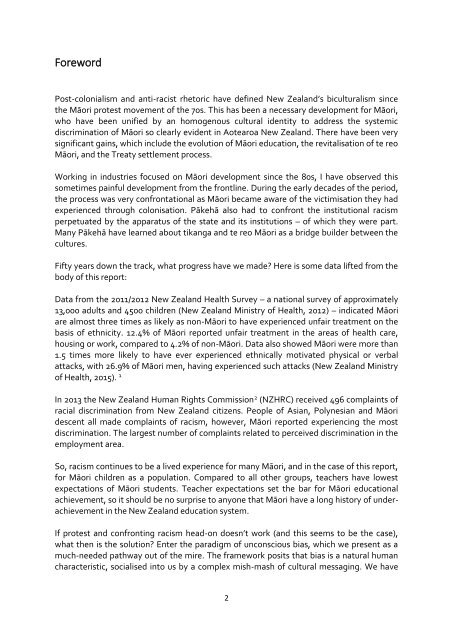UNCONSCIOUS BIAS AND EDUCATION
unconsious-bias-and-education
unconsious-bias-and-education
Create successful ePaper yourself
Turn your PDF publications into a flip-book with our unique Google optimized e-Paper software.
Foreword<br />
Post-colonialism and anti-racist rhetoric have defined New Zealand’s biculturalism since<br />
the Māori protest movement of the 70s. This has been a necessary development for Māori,<br />
who have been unified by an homogenous cultural identity to address the systemic<br />
discrimination of Māori so clearly evident in Aotearoa New Zealand. There have been very<br />
significant gains, which include the evolution of Māori education, the revitalisation of te reo<br />
Māori, and the Treaty settlement process.<br />
Working in industries focused on Māori development since the 80s, I have observed this<br />
sometimes painful development from the frontline. During the early decades of the period,<br />
the process was very confrontational as Māori became aware of the victimisation they had<br />
experienced through colonisation. Pākehā also had to confront the institutional racism<br />
perpetuated by the apparatus of the state and its institutions – of which they were part.<br />
Many Pākehā have learned about tikanga and te reo Māori as a bridge builder between the<br />
cultures.<br />
Fifty years down the track, what progress have we made? Here is some data lifted from the<br />
body of this report:<br />
Data from the 2011/2012 New Zealand Health Survey – a national survey of approximately<br />
13,000 adults and 4500 children (New Zealand Ministry of Health, 2012) – indicated Māori<br />
are almost three times as likely as non-Māori to have experienced unfair treatment on the<br />
basis of ethnicity. 12.4% of Māori reported unfair treatment in the areas of health care,<br />
housing or work, compared to 4.2% of non-Māori. Data also showed Māori were more than<br />
1.5 times more likely to have ever experienced ethnically motivated physical or verbal<br />
attacks, with 26.9% of Māori men, having experienced such attacks (New Zealand Ministry<br />
of Health, 2015). 1<br />
In 2013 the New Zealand Human Rights Commission 2 (NZHRC) received 496 complaints of<br />
racial discrimination from New Zealand citizens. People of Asian, Polynesian and Māori<br />
descent all made complaints of racism, however, Māori reported experiencing the most<br />
discrimination. The largest number of complaints related to perceived discrimination in the<br />
employment area.<br />
So, racism continues to be a lived experience for many Māori, and in the case of this report,<br />
for Māori children as a population. Compared to all other groups, teachers have lowest<br />
expectations of Māori students. Teacher expectations set the bar for Māori educational<br />
achievement, so it should be no surprise to anyone that Māori have a long history of underachievement<br />
in the New Zealand education system.<br />
If protest and confronting racism head-on doesn’t work (and this seems to be the case),<br />
what then is the solution? Enter the paradigm of unconscious bias, which we present as a<br />
much-needed pathway out of the mire. The framework posits that bias is a natural human<br />
characteristic, socialised into us by a complex mish-mash of cultural messaging. We have<br />
2


